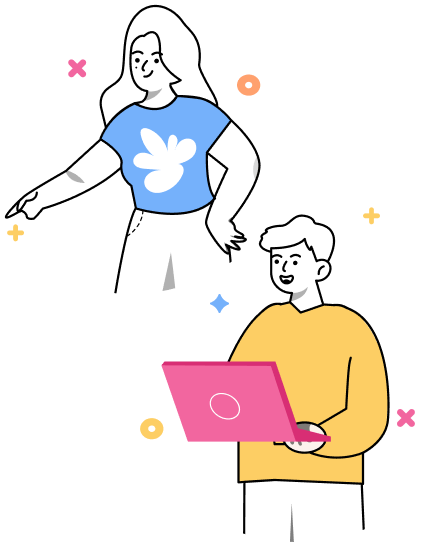18 Ways to Boost Employee Morale That Actually Work
Discover 18 tangible ways to boost employee morale using interactive team activities and tools that spark group connection, collaboration, and engagement.

18 Employee Morale Boosters Your HR Team Should Be Using in 2025
When your team stops showing initiative and communication feels strained, it’s a sign of low employee morale.
Understanding what drives employee morale is crucial for maximizing employees’ potential, improving engagement, and achieving positive outcomes.
Although some leaders try to build morale with benefits, retreats, or wellness perks, these tactics don’t always solve the problem for every team.
In this article, you’ll learn how to increase employee morale with 18 proven strategies that build connection, boost energy, and strengthen team commitment.
18 Tangible Ways to Boost Employee Morale
Here are 18 employee morale boosters you can use to create a more engaged, motivated, and high-performing team:
1. Communicate Openly With Your Team
Two-way communication is one of the most effective ways to boost employee morale, especially for younger employees. According to a study, 39% of employers who let go of Gen Z hires cite communication gap as the key reason.
Creating space for honest dialogue and shared problem-solving helps employees feel heard, not just managed. To build trust among all employees, use communication styles that fit different preferences, including face-to-face check-ins, messaging apps, and visually engaging tools.
💡 How to do it better:
Listen more in a systematized way. Set up skip-levels and regular one-on-ones with each direct report. Nissan implemented listening events, such as "Ask Us Anything” sessions, skip-level meetings, and floor walkarounds to gather honest employee feedback across all levels, and their employee morale shot up.
2. Develop Core Leadership Skills
Employee morale is deeply influenced by how you lead. Two leadership styles in particular can make a lasting impact:
- Authentic leadership focuses on transparency, consistency, and values. When employees trust their leaders to be honest and fair, it builds loyalty and a sense of stability, even during tough decisions.
- Engaging leadership involves aligning individual strengths with team goals, supporting career growth, and giving people autonomy.
When leaders coach instead of control, and empower rather than micromanage, employees are more likely to feel fulfilled, motivated, and committed to their work.
💡How to do it better:
Build trust by practicing open decision-ma3. Reward Incentives That Reinforce Desired Behaviors
Reward high-performing employees to reinforce behaviors you want to see more of, like teamwork, problem-solving, or hitting goals. When employees know what gets recognized, they’re more likely to repeat it.
Small incentives, like gift cards, extra time off, or bonuses, tied to clear actions, can increase employee morale.
3. Reward Incentives That Reinforce Desired Behaviors
Reward high-performing employees to reinforce behaviors you want to see more of, like teamwork, problem-solving, or hitting goals. When employees know what gets recognized, they’re more likely to repeat it.
Small incentives, like gift cards, extra time off, or bonuses, tied to clear actions, can increase employee morale.
💡 How to do it better:
Google links bonuses and stock awards directly to structured performance reviews and peer input, so rewards are seen as earned, not arbitrary. If you're not offering stock, make your reward process transparent. Explain why someone was recognized and tie it to behaviors others should repeat. That clarity builds trust and keeps morale high.
4. Turn Onboarding Into an Interactive Experience
Help new hires understand the company’s values, mission, and behavioral norms early through an interactive onboarding process. This increases long-term morale and retention.
If you’re wondering how to boost employee morale from day one, skip the boring handbooks. Walk your new hires through your systems with interactive sessions.
💡 How to do it better:
You can use Slides With Friends to run polls, quizzes, or Q&As on your training module. This encourages new employees to participate, reinforce group learning, and build early confidence.
5. Offer Cross-Training Opportunities
Cross-training gives employees a chance to learn skills outside their primary roles. According to a report, companies that offer cross-training opportunities saw a 39% increase in employee retention rate.
Rotate team members into diverse roles for a few hours per week. These experiences improve team building and show employees that you’re invested in their growth, which increases morale.
💡 How to do it better:
Run an anonymous poll in Slides With Friends asking, “Which area of the business would you like to learn more about?” Use the results to develop your cross-training plan.
king. Host short “Here’s what I’m thinking” sessions where you share in-progress decisions and ask for team input. According to a study, leaders who openly share their reasoning and uncertainties build stronger employee trust and long-term morale.
6. Foster Psychological Safety on Mistakes
Fear of making mistakes can easily lower morale. Leaders can prevent this by building psychological safety that encourages open dialogue and learning from mistakes. This improves your team's learning, efficacy, and overall productivity.
When employees feel safe admitting mistakes, morale improves, and teams work better together.
💡 How to do it better:
In a team debrief, ask, “What did we learn from this mistake?” and “Where can we go from here?” instead of pointing fingers. This creates a space where people reflect, share openly, and improve together. The goal is that you’re all on “team [project]”, with the shared goal of success. If the vibe is “mistakes don’t matter really, only how we move from where we are,” people are both less afraid and (therefore) more motivated to move and work hard.
7. Provide Clear Career Roadmaps
Show employees clear career paths on how they can grow within your company. For example, a junior marketing associate might want to move into a specialist role within 18 months. You can map out the skills, goals, and responsibilities tied to the role.
This helps employees take ownership of their career development, boosts morale, and fosters long-term engagement.
💡 How to do it better:
Hold quarterly career check-ins using an interactive presentation that includes skills gained, next role goals, and support needed. Ask each team member to list 1–2 skills they want to grow this quarter.
You can use the team-building deck on Slides With Friends to run live polls. Ask your team to vote on what roles or skills they want next. Use that data to define paths and develop them first.
8. Improve Work Conditions Based on Employee Input
Employee morale depends on your physical or digital work environment. A survey found that 89% of employees satisfied with their environment feel more positively about their employer.
But “workspace” today isn’t one-size-fits-all. It includes office layout, remote tools, meeting norms, and even noise levels or surveillance.
To improve morale, ask your team what helps or hinders their daily flow. In office settings, that could mean better lighting, quiet zones, or flexible seating.
Remote/hybrid teams might prefer reducing unnecessary meetings, improving async tools, or offering stipends for home office upgrades.
💡How to do it better:
Get employee feedback with group surveys and conduct them live to encourage more responses. Slides With Friends lets you create an interactive survey to run together, with built-in morale boosting.
9. Create Moments for Peer-to-Peer Appreciation
Create clear, simple ways for employees to recognize each other regularly. Research shows employees who get weekly peer praise feel 9 times more belonging, are 2.6 times more productive, and are nearly 6 times more likely to stay long-term.
This helps you build trust, boost morale, and encourage behaviors that drive team success.
💡 How to do it better:
Zappos empowered employees to award colleagues who embody its core values via a peer-nominated system that includes gift cards and time off.
You can use Slides With Friends to hold “Employee Appreciation Day,” where your team can vote on rewards, awards, polls, and photo shares. You can ask: “Who made your work week easier?” or “Which teammate best showed our company values?” The responses generate live word clouds or leaderboards that spark energy and connection.
10. Turn Knowledge Sharing into Group Collaboration
Collaborative learning boosts employee morale and connection. You can use learning experience tools that encourage group collaboration, especially in virtual settings.
💡 How to do it better:
During onboarding or internal workshops, don’t just read through slides. Use interactive employee training decks with Q&As, word clouds, or open prompts. This keeps sessions engaging and helps new and old employees learn from each other.
11. Address Workload Issues Openly
Check in on your team workload and address issues openly. Ask who’s overloaded, listen to what they need, and adjust things where you can. Giving clear feedback, supportive managers, and job control boosts morale and engagement.
A small shift in tasks or giving flexibility can make a big difference. When people feel supported, they’re more likely to stay energized.
💡 How to do it better:
- Add a 5-minute team check-in slide at the start or end of your weekly meeting using this morale check-in deck.
- Include anonymous polls like “How’s your workload today?” or “What’s draining your energy?” to spark honest input.
- Review the responses privately, then follow up 1:1 or adjust team priorities based on what comes up.
12. Offer Mental Health Programs
Employees who have access to structured mental health resources, like counseling, stress education, and employee assistance programs, report higher morale.
Make mental health resources visible, stigma-free, and part of everyday conversation. You can add them in onboarding materials, monthly check-ins, and internal wellness updates.
💡 How to do it better:
Hold mental health workshops to discuss identity and workplace culture. For example, host sessions on microaggressions and stress, mental health stigma in different cultures, or how to support LGBTQ+ colleagues emotionally. Use our Pride Month template to encourage inclusiveness.
13. Promote Work-Life Balance
Long hours and constant availability wear people down. Offering flexible hours and limiting unnecessary overtime helps employees recharge.
It also improves focus, lowers stress, and reduces turnover. A healthier work rhythm leads to better morale and fewer burnout cases.
💡 How to do it better:
Discourage a culture of hero hours. If you notice someone consistently working late, check in and help redistribute their workload or clarify priorities. Make sure people take their vacation days (you can track who isn’t and nudge them to recharge).
14. Use Reliable Technology to Reduce Frustration
A report found that 35% of employees blame slow or unreliable tech for low productivity, especially in hybrid work environments. Upgrading systems and streamlining digital workflows shows employees that their time is valued.
💡 How to do it better:
Use automation tools to handle repetitive tasks, and hold short walkthroughs when rolling out new systems. This reduces stress and gives them more time for meaningful work, all of which protects morale and reduces burnout.
15. Involve Employees in Decision-Making
Giving employees a voice in company decisions helps them feel empowered. According to self-determination theory, giving autonomy can directly improve the motivation and emotional well-being of people.
You can run interactive meetings where employees can share input, vote on ideas, and feel heard in the decision-making process.
💡 How to do it better:
Use a team-based SWOT analysis template to involve employees in solving real challenges. Ask them to list strengths, weaknesses, opportunities, and threats around a project or team goal. Then vote on which ideas to act on using a Slides With Friends poll. This helps employees see their input shaping real outcomes.
16. Fair and Competitive Compensation
Compensation plays a big role in how valued people feel at work. A Gallup study shows that about 30% of employees who quit said that better compensation or benefits might have convinced them to stay.
Make sure your salaries and benefits are competitive with others in your industry, and stay consistent across similar roles on your team.
💡 How to do it better:
Go beyond just base pay by offering solid benefits like health coverage, bonuses, and retirement plans. This shows you care about your team’s well-being.
17. Introduce Brief “Booster Breaks” in the Workday
Stress builds up when work feels nonstop. Add short, structured breaks, just 5 to 10 minutes, for stretching, breathwork, or mindfulness. This improves focus, lowers anxiety, and boosts emotional energy throughout the day.
💡How to do it better:
- Schedule a 5-minute stretch or breathing break during low-energy times like mid-morning or 3 p.m., and invite the whole team to join via video or in person.
- Use a timer slide from Slides With Friends to mark the break visually in meetings—set it to soft music and label it “Booster Break: Stretch, breathe, or grab water.”
18. Hold Themed Activities
Simple seasonal games or light competitions, like trivia games, guessing contests, or themed decks, lift team spirits while keeping everyone engaged. Research shows that having fun at work triggers positive emotions and can increase intrinsic motivation and creativity.
For example, you can run a quick “Guess the Baby Photo” game during a holiday week, where team members submit childhood pictures and others vote anonymously.
💡How to do it better:
- Pick a monthly theme like “Around the World” and let each team member share a fun fact, food, or photo from a different country.
- Use a Slides With Friends photo share or poll slide to vote on the most surprising or creative entry.
What is Employee Morale and Why Is It Important?
Employee morale is how people feel about their job, their coworkers, and their workplace. It shows how motivated they feel, how they interact with others, and how much they care about the outcome of their work.
When morale is high, teams work with energy, solve problems faster, and support one another. Employees feel proud of their work, speak up more, share ideas, or help a teammate without being asked.
When morale is low, the opposite happens. Employees miss deadlines, avoid team meetings, or do the bare minimum work.
For example, a motivated team might brainstorm ways to solve a client issue together, while a low-morale team might ignore the problem or rely on you to fix it.
How to Measure Employee Morale?
Here’s how you can measure your employee morale:
Use Pulse Surveys
Pulse surveys are short questionnaires that help you measure how employees feel in real time. They help you spot issues that lead to burnout or disengagement.
For example, if fewer employees say “I feel supported at work,” it could be an early sign of low morale.
You can tailor pulse surveys to your current events, like team restructuring or return-to-office plans, to get timely feedback. This helps you understand your employees’ mindset.
Have One-on-One Conversations
Private conversations give your employees space to share. You’ll hear how motivated or frustrated they feel, what’s affecting their work, and what support they might need.
These talks help you build a safe culture and understand morale on a personal level, beyond what surveys can show.
Collect Anonymous Feedback
You can collect anonymous feedback for honest input using tools like suggestion boxes or feedback forms. For example, if multiple employees mention poor communication, unclear priorities, or feeling undervalued, it’s a sign of low morale.
Conduct Stay Interviews
Stay interviews are one-on-one conversations where you ask employees why they stay and what could make their experience better. Unlike exit interviews, they’re proactive.
They help you understand hidden concerns, build trust, and prevent disengagement before it starts.
Track Engagement Metrics
Monitor metrics, like meeting participation rates, message response times, task completion delays, and absenteeism frequency. A sudden change in these patterns can signal disengagement or dissatisfaction.
How Slides With Friends Helps You Increase Employee Morale

Boosting employee morale is easy if you use the right tools that encourage participation and engagement.
Slides With Friends is a presentation software that turns your ordinary meetings, training sessions, or check-ins into dynamic experiences. It is designed for team leaders, HR leads, trainers, and managers.
Here’s how to improve employee morale using Slides With Friends:
Run Live Polls, Q&As, and Word Cloud with Instant Feedback

Slides With Friends offers interactive features like live polls, open Q&As, quizzes, and word clouds. This allows your team to join the conversation in real time.
Here’s how it works:
- Participants join using a QR code or link and submit answers from any device.
- Slides With Friends tallies responses in the background as you move through your slides.
- Results appear instantly as charts, word clouds, or leaderboards, ready to spark live discussion or feedback.
Slides With Friends provides 100+ pre-made templates, ranging from onboarding activities to team-building challenges. You can edit these to align with your content and branding.
For example, if you’re holding a training session, you can mix your content with fun games to reinforce learning.
Or you can conduct a live poll on what the team should cover for the week. This makes employees feel heard and valued.
Kick-Off Meetings with Icebreakers and Trivia Games

If you don’t use interactive tools that motivate employees to participate, meetings become just another obligation.
With Slides With Friends, you can kick off meetings using lighthearted icebreakers that get people talking, smiling, and engaging from the start. These small moments of connection set the tone for open, collaborative conversations.
You can also hold trivia games with built-in scoring and leaderboards to spark friendly competition. These games show you team dynamics, like who collaborates well, who takes initiative, and how different personalities contribute.
This helps you create shared moments that lift morale and turn passive meetings into meaningful conversations.
Use Engagement Tools to Break The Routine

Repetitive meetings and rigid routines can wear down team energy and morale.
Slides With Friends lets employees interact using fun avatars, emojis, and soundboards that add personality and playfulness to your meetings.

Simply share your screen and click “Start the Event.” The platform generates a unique QR code that your employees can scan to join in. They can choose avatars and fun usernames to represent themselves.
As you move through slides, participants can interact with them using emoji or soundboard reactions. These light touches create memorable team rituals that people actually look forward to.
Measure What Motivates Your Employees

Slides With Friends provides slide-by-slide analytics, so you can see exactly where your team engaged. For example, you can analyze how many voted in a poll, joined a word cloud, or responded to a prompt.
These insights help you measure your team’s morale and plan your sessions based on what your team actually enjoys.
When employees feel like meetings are designed with their experience in mind, they’re more likely to participate. And this thoughtful engagement can be a morale booster.
With Slides With Friends, you build team experiences that encourage open communication, timely recognition, and meaningful conversations. This helps your employees feel heard, valued, and motivated.
Sign up for free to see how Slides With Friends can boost employee morale and drive real team engagement.


Ready to ditch the dull, and run team sessions that people will actually enjoy?
Get started with a Slides with Friends deck in no time. We’ve got all the interactive features you need in one easy-to-learn, easy-to-set-up tool.














